Uses
Promethazine is used to prevent and treat nausea and vomiting related to certain conditions (such as before/after surgery, motion sickness). It is also used with other medication to treat severe allergic reactions (anaphylaxis) and reactions to blood products. It may also be used to treat milder allergic reactions when you cannot take promethazine by mouth. It may also be used to help you feel sleepy/relaxed before and after surgery, during other procedures, or during labor and delivery. It may also be used to help certain opioid pain relievers (such as meperidine) work better.Promethazine is an antihistamine and works by blocking a certain natural substance (histamine) that your body makes during an allergic reaction. Its other effects (such as anti-nausea, calming, pain relief) may work by affecting other natural substances (such as acetylcholine) and by acting directly on certain parts of the brain.This drug is not approved for use in children younger than 2 years due to an increased risk of side effects (such as slow/shallow breathing). See also Warning section.
How to use Phenergan Vial
See also Warning section.
It is best to inject this medication deep into a muscle. It may also be given by injection slowly into a large vein by a health care professional. Do not inject this medication under the skin or into an artery. For nausea and vomiting, use this medication as directed by your doctor, usually every 4 hours as needed. If you have any questions about the proper use of this medication, ask your doctor or pharmacist.
If you are using this medication at home, learn all preparation and usage instructions from your health care professional. Before using, check this product visually for particles or discoloration. If either is present, do not use the liquid. Learn how to store and discard medical supplies safely.
The dosage and how often you receive this medication are based on your age, medical condition, and response to treatment. Children's dosage may also be based on weight. Do not increase your dose or use this medication more often or for longer than prescribed. Your condition will not improve any faster, and your risk of side effects will increase.
Tell your doctor if you do not get better or if you get worse.
Side Effects
See also Warning section.
Drowsiness, dizziness, constipation, blurred vision, or dry mouth may occur. If any of these effects last or get worse, tell your doctor or pharmacist promptly.
To relieve dry mouth, suck (sugarless) hard candy or ice chips, chew (sugarless) gum, drink water, or use a saliva substitute.
Remember that this medication has been prescribed because your doctor has judged that the benefit to you is greater than the risk of side effects. Many people using this medication do not have serious side effects.
Tell your doctor right away if you have any serious side effects, including: signs of infection (such as sore throat that doesn't go away, fever, chills), loss of coordination, fainting, confusion, slow heartbeat, shaking (tremor), unusual/uncontrolled movements (such as fixed upward stare, neck twisting, tongue movements), mental/mood changes (such as hallucinations, nervousness, irritability, restlessness, confusion), trouble urinating, easy bleeding/bruising, severe stomach/abdominal pain, yellowing of eyes/skin.
Get medical help right away if you have any very serious side effects, including: slow/shallow breathing, seizures.
This medication may rarely cause a very serious condition called neuroleptic malignant syndrome (NMS). Get medical help right away if you have any of the following symptoms: fever, muscle stiffness/pain/tenderness/weakness, severe tiredness, severe confusion, sweating, fast/irregular heartbeat, dark urine, signs of kidney problems (such as change in the amount of urine).
A very serious allergic reaction to this drug is rare. However, get medical help right away if you notice any symptoms of a serious allergic reaction, including: rash, itching/swelling (especially of the face/tongue/throat), severe dizziness, trouble breathing.
This is not a complete list of possible side effects. If you notice other effects not listed above, contact your doctor or pharmacist.
In the US -
Call your doctor for medical advice about side effects. You may report side effects to FDA at 1-800-FDA-1088 or at www.fda.gov/medwatch.
In Canada - Call your doctor for medical advice about side effects. You may report side effects to Health Canada at 1-866-234-2345.
Warnings
Promethazine should not be used by children younger than 2 years because it may cause serious (possibly fatal) slow/shallow breathing. When this medication is used by children 2 years and older, use the lowest effective dosage and avoid other drugs that affect breathing. Get medical help right away if slow/shallow breathing occurs.
In children, drugs for nausea should only be used in cases of prolonged vomiting of a known cause. Avoid use of promethazine in children with liver disease (including possible Reye's syndrome).
This medication can cause severe tissue damage, possibly requiring surgery. Tell your health care professional right away if you have burning, pain, redness, swelling, or numbness at or near the injection site. If this occurs, the injection should be stopped and the injection site checked.
It is preferred that this medication be given by injection into a muscle. There may be an increased risk of side effects if this medication is given by injection into a vein. This medication must not be given by injection under the skin.
Precautions
See also Warning section.
Before using promethazine, tell your doctor or pharmacist if you are allergic to it; or to any other phenothiazines (such as prochlorperazine); or if you have any other allergies. This product may contain inactive ingredients (such as sulfites including sodium metabisulfite), which can cause allergic reactions or other problems. Talk to your pharmacist for more details.
Before using this medication, tell your doctor or pharmacist your medical history, especially of: breathing problems (such as asthma, chronic obstructive pulmonary disease-COPD, sleep apnea), blood/immune system problems (such as bone marrow depression), high pressure in the eye (glaucoma), heart disease (such as angina, irregular heartbeat), high or low blood pressure, liver disease, certain brain disorders (such as neuroleptic malignant syndrome, Reye's syndrome, seizures), stomach/intestinal problems (such as blockage, ulcer), trouble urinating (for example, due to enlarged prostate).
This drug may make you dizzy or drowsy or blur your vision. Alcohol or marijuana (cannabis) can make you more dizzy or drowsy. Do not drive, use machinery, or do anything that needs alertness or clear vision until you can do it safely. Avoid alcoholic beverages. Talk to your doctor if you are using marijuana (cannabis). Children should be supervised during bicycle riding and other possibly hazardous activities to avoid injury.
Before having surgery, tell your doctor or dentist about all the products you use (including prescription drugs, nonprescription drugs, and herbal products).
This medication may make you more sensitive to the sun. Limit your time in the sun. Avoid tanning booths and sunlamps. Use sunscreen and wear protective clothing when outdoors. Tell your doctor right away if you get sunburned or have skin blisters/redness.
This medication may make you sweat less, making you more likely to get heat stroke. Avoid doing things that may cause you to overheat, such as hard work or exercise in hot weather, or using hot tubs. When the weather is hot, drink a lot of fluids and dress lightly. If you overheat, quickly look for a place to cool down and rest. Get medical help right away if you have a fever that does not go away, mental/mood changes, headache, or dizziness.
Older adults may be more sensitive to the side effects of this drug, especially drowsiness, confusion, constipation, or trouble urinating. Drowsiness and confusion can increase the risk of falling.
Children may be more sensitive to the side effects of this drug, especially slowed breathing and uncontrolled movements (see also Warning section). This drug can often cause excitement in young children instead of drowsiness. Special care should be taken when using this medication in children who have lost a lot of fluid (dehydration), those who have a family history of sudden infant death syndrome (SIDS), and those who are hard to wake up from sleep.
During pregnancy, this medication should be used only when clearly needed. Discuss the risks and benefits with your doctor.
It is unknown if promethazine passes into breast milk. It may have undesirable effects on a nursing infant. Consult your doctor before breastfeeding.
Interactions
Drug interactions may change how your medications work or increase your risk for serious side effects. This document does not contain all possible drug interactions. Keep a list of all the products you use (including prescription/nonprescription drugs and herbal products) and share it with your doctor and pharmacist. Do not start, stop, or change the dosage of any medicines without your doctor's approval.
Some products that may interact with this drug include: antihistamines applied to the skin (such as diphenhydramine cream, ointment, spray), metoclopramide.
The risk of serious side effects (such as slow/shallow breathing, severe drowsiness/dizziness) may be increased if this medication is used with other products that may also cause drowsiness or breathing problems. Tell your doctor or pharmacist if you are taking other products such as opioid pain or cough relievers (such as codeine, hydrocodone), alcohol, marijuana (cannabis), drugs for sleep or anxiety (such as alprazolam, lorazepam, zolpidem), muscle relaxants (such as carisoprodol, cyclobenzaprine), or other antihistamines (such as cetirizine, diphenhydramine).
Check the labels on all your medicines (such as allergy or cough-and-cold products) because they may contain ingredients that cause drowsiness. Ask your pharmacist about using those products safely.
This medication may interfere with certain lab tests (such as some pregnancy tests, blood sugar tests), possibly causing false test results. Make sure lab personnel and all your doctors know you use this drug.
Overdose
If someone has overdosed and has serious symptoms such as passing out or trouble breathing, call 911. Otherwise, call a poison control center right away. US residents can call 1-800-222-1222. Canada residents can call 1-844-764-7669. Symptoms of overdose may include: severe drowsiness/dizziness, fainting, slow/shallow breathing, seizures, muscle stiffness/twitching, widened pupils. In children, mental/mood changes (such as restlessness, irritability, hallucinations) may occur before drowsiness.
Do not share this medication with others.
If you are using this medication on a regular schedule and you miss a dose, use it as soon as you remember. If it is near the time of the next dose, skip the missed dose. Use your next dose at the regular time. Do not double the dose to catch up.
Store at room temperature away from light and moisture. Do not store in the bathroom. Keep all medications away from children and pets.
Do not flush medications down the toilet or pour them into a drain unless instructed to do so. Properly discard this product when it is expired or no longer needed. Consult your pharmacist or local waste disposal company.
Images
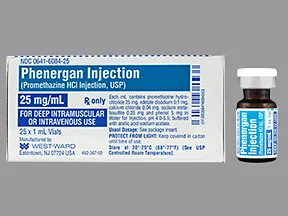
Phenergan 25 mg/mL injection solution
Color: colorlessShape: Imprint:This medicine is a colorless, clear, vial
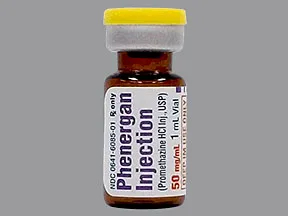
Phenergan 50 mg/mL injection solution
Color: colorlessShape: Imprint:This medicine is a colorless, clear, vial
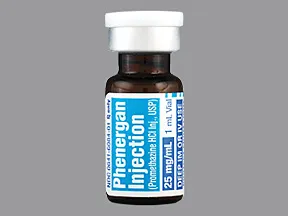
Phenergan 25 mg/mL injection solution
Color: colorlessShape: Imprint:This medicine is a colorless, clear, vial
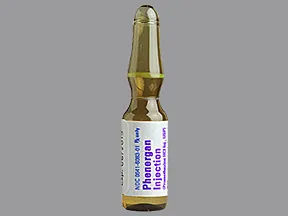
Phenergan 50 mg/mL injection solution
Color: colorlessShape: Imprint:This medicine is a colorless, clear, vial
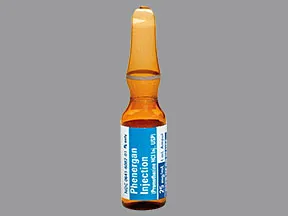
Phenergan 25 mg/mL injection solution
Color: colorlessShape: Imprint:This medicine is a colorless, clear, vial
Are you currently using Phenergan Vial?
This survey is being conducted by the WebMD marketing sciences department.
Selected from data included with permission and copyrighted by First Databank, Inc. This copyrighted material has been downloaded from a licensed data provider and is not for distribution, except as may be authorized by the applicable terms of use.
CONDITIONS OF USE: The information in this database is intended to supplement, not substitute for, the expertise and judgment of healthcare professionals. The information is not intended to cover all possible uses, directions, precautions, drug interactions or adverse effects, nor should it be construed to indicate that use of a particular drug is safe, appropriate or effective for you or anyone else. A healthcare professional should be consulted before taking any drug, changing any diet or commencing or discontinuing any course of treatment.